

Smithsonian Ocean Portal. The threats faced by our ocean planet may seem overwhelming.

In the face of pollution, climate change, overfishing, and other daunting problems, what you can do on your own may seem like a drop in the bucket. But if we begin working together now, we can make a huge difference. Here are some ways to get started: Make the ConnectionThe first step in making a difference is learning about the ocean and how your actions have an impact. Keep reading to learn everyday things you can do to help protect and restore the seas. Be Water Wise All water on Earth is connected. . • In the yard: Use as little fertilizer as possible. . • On the table: Look for fruits and vegetables that are grown without pesticides (and don't spray them in your own garden)
. • In the house: Choose non-toxic cleaning products and low-phosphate detergents. Trim Down Trash Remember that trash we "throw away" doesn't disappear. . • Ditch the disposable lifestyle: Make a point to use reusable bags, beverage cups, and food containers. Great Pacific Garbage Patch - National Geographic Society. The Great Pacific Garbage Patch is a collection of marine debris in the North Pacific Ocean.
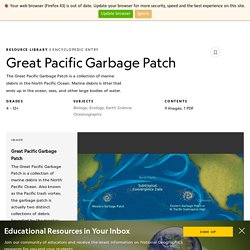
Marine debris is litter that ends up in oceans, seas, and other large bodies of water. The Great Pacific Garbage Patch, also known as the Pacific trash vortex, spans waters from the West Coast of North America to Japan. The patch is actually comprised of the Western Garbage Patch, located near Japan, and the Eastern Garbage Patch, located between the U.S. states of Hawaii and California. These areas of spinning debris are linked together by the North Pacific Subtropical Convergence Zone, located a few hundred kilometers north of Hawaii. First of Its Kind Map Reveals Extent of Ocean Plastic. When marine ecologist Andres Cozar Cabañas and a team of researchers completed the first ever map of ocean trash, something didn't quite add up. Their work, published this month in the Proceedings of the National Academy of Sciences, did find millions of pieces of plastic debris floating in five large subtropical gyres in the world's oceans. But plastic production has quadrupled since the 1980s, and wind, waves, and sun break all that plastic into tiny bits the size of rice grains.
So there should have been a lot more plastic floating on the surface than the scientists found. "Our observations show that large loads of plastic fragments, with sizes from microns to some millimeters, are unaccounted for in the surface loads," says Cozar, who teaches at the University of Cadiz in Spain, by e-mail. "But we don't know what this plastic is doing. What effect those plastic fragments will have on the deep ocean—the largest and least explored ecosystem on Earth—is anyone's guess. One Answer. How Big Is the "Great Pacific Garbage Patch"? Science vs. Myth. UPDATED FEBRUARY 7, 2013 -- While everything may be bigger in Texas, some reports about the "Great Pacific Garbage Patch" would lead you to believe that this marine mass of plastic is bigger than Texas—maybe twice as big as the Lone Star State, or even twice as big as the continental U.S.
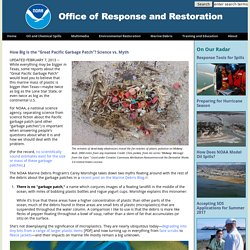
For NOAA, a national science agency, separating science from science fiction about the Pacific garbage patch (and other "garbage patches") is important when answering people's questions about what it is and how we should deal with the problem. Marine Debris Impacts. Environmental impacts are wide ranging and can be both direct and indirect.
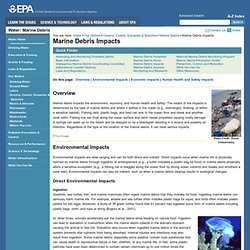
Direct impacts occur when marine life is physically harmed by marine debris through ingestion or entanglement (e.g., a turtle mistakes a plastic bag for food) or marine debris physically alters a sensitive ecosystem (e.g., a fishing net is dragged along the ocean floor by strong ocean currents and breaks and smothers a coral reef). Environmental impacts can also be indirect, such as when a marine debris cleanup results in ecological changes. Direct Environmental Impacts Ingestion Seabirds, sea turtles, fish, and marine mammals often ingest marine debris that they mistake for food. Ingesting marine debris can seriously harm marine life. Photo Credit: National Oceanic and Atmospheric Administration At other times, animals accidentally eat the marine debris while feeding on natural food.
Entanglement Marine life can become entangled in marine debris causing serious injury or death. Plastic Bag Statistics. This Is How Your Plastic Bag Ends Up In Massive Ocean Garbage Patches. Risks to Oceans. There are three main ways that the ocean water quality is at risk.
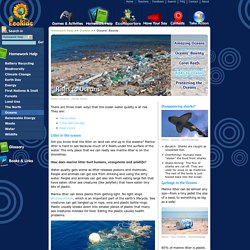
They are: How Many Plastic Bags? Patch in Ocean. Questions.
Patch trash. Garbage Dump in the Middle of the Pacific Ocean. Sometimes, people are lazy and don't want to get up and find a trash can.
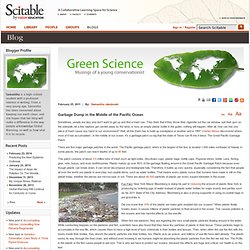
They think that if they throw their cigarette out the car window, spit their gum on the sidewalk, let a few napkins get carried away by the wind, or toss an empty plastic bottle in the gutter, nothing will happen. After all, how can this one piece of trash cause any harm to our environment? Well, all this trash has to build up someplace or another and in 1997 Charles Moore discovered where most of it has accumulated - in the middle of our ocean.
It's a garbage patch so big that the state of Texas can fit into it twice. Onswipe.